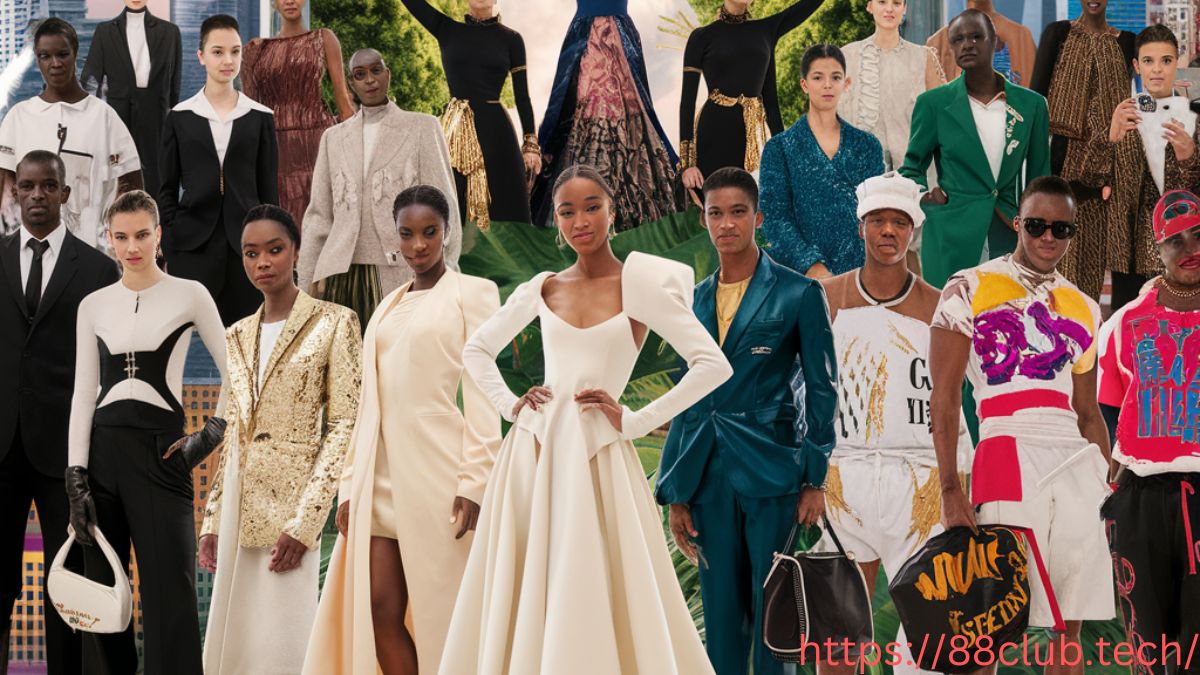The fashion industry refers to the business of creating, marketing, and selling clothing, accessories, and footwear. It is a global sector that encompasses a wide range of activities, from designing and manufacturing to retail and marketing. This dynamic industry has a profound influence on cultural, social, and economic trends worldwide, with millions of people involved in the production, consumption, and promotion of fashion.
Every season, the fashion world transforms, bringing new trends, innovations, and styles that shape how we express ourselves. From the elegance of haute couture to the street style of urban fashion, the fashion industry constantly reinvents itself, pushing boundaries and setting new standards. Whether you’re a fashion enthusiast or just someone curious about the latest trends, this world never stops evolving.
In recent years, the fashion industry has embraced technology, sustainability, and inclusivity, making it more diverse and forward-thinking than ever before. With digital fashion shows, eco-friendly fabrics, and a growing focus on consumer identity, the industry is becoming more accessible and responsive to global changes. As it continues to grow and innovate, fashion is more than just a way to dress—it’s a reflection of culture, values, and creativity.
The Key Sectors of the Fashion Industry
The fashion industry isn’t just about the clothes we wear. It encompasses a wide array of sectors that work together to bring fashion from the designer’s sketchbook to our closets. These sectors include:
- Fashion Design and Development: The birthplace of creativity, where designers craft collections that represent artistic visions.
- Fashion Manufacturing: The process of transforming raw materials into finished garments, often through complex supply chains.
- Fashion Retail and E-Commerce: The channels that bring fashion to the consumer, both online and offline.
- Fashion Marketing: Building brand awareness, setting trends, and connecting fashion houses with their target audiences.
0Together, these sectors ensure that the fashion industry runs smoothly, staying relevant and innovative while meeting consumer demand.
Textile Design and Production: The Fabric of Fashion
At the very heart of fashion lies the textile industry. This industry plays a vital role in creating the fabrics that define each collection. From natural fibers like cotton and wool to synthetic fibers like polyester, the choice of materials directly impacts the design, wearability, and cost of the final garment.
Types of Fabrics:
- Natural Fibers: Cotton, silk, wool, linen
- Synthetic Fibers: Polyester, acrylic, nylon, spandex
- Innovative Fabrics: Eco-friendly textiles, smart fabrics, and bio-based materials.
The rise of sustainable fabrics, such as organic cotton and recycled polyester, is reshaping how we view fabric manufacturing. Many designers and brands are turning toward these materials to reduce their environmental footprint and meet the growing demand for eco-conscious fashion.
Fashion Design and Manufacturing: Crafting Fashion from Concept to Creation
The process of fashion design is where creativity and technical skill meet. Designers conceptualize collections by drawing inspiration from various sources like art, culture, and current events. Once the initial designs are drafted, the manufacturing process begins.
Fashion manufacturing involves:
- Pattern Making: Translating design sketches into patterns that form the structure of the garment.
- Fabric Cutting and Assembly: Using digital fabric cutting technology to create pieces, followed by assembly through sewing machines and high-speed machinery.
- Garment Finishing: Adding the final touches like labels, buttons, and zippers to ensure the garment is complete.
The apparel industry has undergone a major transformation with the introduction of 3D design technologies and on-demand production, making fashion more agile and consumer-driven.
Fashion Shows: A Global Showcase of Creativity
Fashion shows, whether haute couture or ready-to-wear, have long been the centerpiece of the fashion industry. These events serve as the ultimate stage for designers to showcase their latest collections to the world. Cities like Paris, Milan, and New York are known for hosting high-profile events, attracting top influencers, media, and celebrities.
Notable Fashion Weeks:
- Paris Fashion Week: A hub for high fashion and haute couture.
- New York Fashion Week: A major showcase for American designers and trends.
- Milan Fashion Week: Renowned for luxurious Italian brands.
- London Fashion Week: Known for pushing boundaries and showcasing innovative designs.
- Tokyo Fashion Week: Highlighting Asian creativity and trends.
The introduction of digital fashion shows in recent years, especially during the pandemic, has altered how we experience these events. Virtual shows now reach global audiences and offer new opportunities for showcasing fashion in unique ways.
Haute Couture: The Pinnacle of Luxury and Craftsmanship
Haute couture represents the highest form of fashion. These bespoke garments are hand-crafted by top designers and tailored to a client’s exact measurements. Only a select few houses can claim haute couture status, and they represent the epitome of luxury and craftsmanship.
Famous haute couture designers include:
- Coco Chanel: Revolutionized women’s fashion with timeless designs.
- Christian Lacroix: Known for vibrant and theatrical collections.
- Jean Paul Gaultier: Blurred the lines between masculine and feminine styles.
These couture pieces are not meant for mass production but rather serve as the ultimate expression of a designer’s vision. The price tag for these garments can reach into the hundreds of thousands, reflecting their exclusivity and artistry.
Consumer Demand: Shaping the Fashion Landscape
Consumer demand drives the entire fashion industry. As consumers become more aware of issues like sustainability, body inclusivity, and ethical labor practices, their buying habits evolve. The demand for eco-fashion, modest fashion, and plus-size clothing has been growing, forcing brands to adapt to these changes.
Factors Influencing Consumer Demand:
- Cultural Shifts: Movements like #MeToo and Black Lives Matter have spurred conversations about diversity and inclusion in fashion.
- Sustainability: More consumers are demanding eco-friendly products and ethical practices.
- Technology: The rise of online shopping, social media, and influencer marketing has changed how people interact with brands.
Brands that fail to address these demands risk falling behind in a competitive marketplace where consumer preferences shift rapidly.
Fashion Marketing: The Art of Connecting Brands with Consumers
Fashion marketing plays a crucial role in driving sales and creating brand loyalty. Today’s marketing strategies are less about traditional ads and more about creating a connection with consumers. This involves a blend of storytelling, celebrity endorsements, and social media engagement.
Brands now use influencer marketing to promote their collections, leveraging social platforms like Instagram, TikTok, and YouTube to reach younger audiences. This shift is part of the broader trend toward digital marketing and brand transparency, where consumers are increasingly drawn to brands that align with their values.
Fashion Retail: Meeting Consumer Demand Across Channels
The way we shop has drastically changed in recent years. The traditional fashion retail experience, once limited to physical stores, has now expanded to e-commerce and omnichannel platforms. Consumers expect a seamless shopping experience, whether they’re browsing online, picking up in-store, or trying items on via virtual fitting rooms.
Key Trends in Fashion Retail:
- Omnichannel Shopping: Integrating online and offline experiences to create a cohesive customer journey.
- Virtual Try-Ons: Using augmented reality (AR) and AI to simulate how clothes will look without physically trying them on.
- Sustainability in Retail: The rise of second-hand shopping and clothing rental services.
The shift toward online shopping has also impacted traditional retail outlets. Many brick-and-mortar stores are now offering personalized experiences, like curated collections and in-store events, to drive foot traffic.
Fashion Manufacturing: Navigating Innovation and Sustainability
The fashion manufacturing process is being revolutionized by technology. From computer-assisted design (CAD) to digital fabric cutting, manufacturers are embracing innovation to increase efficiency and reduce waste. Additionally, sustainable practices are gaining traction, with many companies exploring eco-friendly materials and ethical labor practices.
On-demand production has become a significant trend in the fashion industry, allowing brands to produce only what’s needed, reducing overproduction and waste. Some companies, like Nike and Adidas, have already adopted 3D printing and other cutting-edge technologies in their manufacturing processes.
Fashion Trends: The Ever-Changing World of Style
Fashion trends are constantly evolving, with new ideas emerging every season. These trends are influenced by everything from celebrity style to global events. Today, fashion trends are often driven by streetwear, sustainability, and cultural movements.
Key Trend Categories:
- Sustainability: Green fashion, upcycling, and eco-friendly fabrics.
- Streetwear: Comfort-driven fashion that blends high and low culture.
- Technology: Smart textiles and wearable tech influencing fashion designs.
The future of fashion trends will likely revolve around personalization, with consumers increasingly looking for designs that reflect their unique identities.
The Future of the Fashion Industry: Innovation, Sustainability, and Technology
The future of the fashion industry promises more sustainable practices, technological advancements, and consumer-centered innovation. The rise of artificial intelligence, augmented reality, and blockchain is already changing how fashion is designed, manufactured, and sold. The focus is now on creating eco-friendly fashion that balances style with environmental impact.
The global fashion market will continue to grow, with emerging markets in Asia and Africa driving significant change. As globalization continues to connect fashion trends and production across borders, the industry will become more diverse and inclusive than ever before.
FAQs about the Fashion Industry
1. What are the major sectors in the fashion industry?
The major sectors include fashion design, manufacturing, retail, marketing, and textile production, each playing a key role in bringing fashion to consumers.
2. How has sustainability impacted the fashion industry?
Sustainability is now a priority, with many brands using eco-friendly materials and adopting ethical practices to reduce their environmental footprint.
3. What are fashion weeks, and why are they important?
Fashion weeks, like those in Paris and New York, showcase upcoming collections from top designers and set trends for the upcoming season.
4. What is fast fashion, and why is it controversial?
Fast fashion involves quickly producing cheap, trendy clothing that mimics runway styles, but it’s criticized for contributing to waste and poor working conditions.
5. How does technology influence the fashion industry today?
Technology is transforming fashion through innovations like 3D design, virtual try-ons, and AI in production and retail, enhancing creativity and efficiency.
Conclusion: A Fashion Industry in Flux
The fashion industry is one of the most dynamic sectors in the world, driven by creativity, innovation, and consumer demand. As the industry embraces technology, sustainability, and inclusivity, it’s clear that the future of fashion will be shaped by both traditional craftsmanship and modern innovation.
Whether it’s haute couture, streetwear, or eco-fashion, the fashion industry will continue to evolve, offering exciting possibilities for consumers, designers, and brands alike.
By understanding the major sectors of fashion, how trends emerge, and the innovations shaping its future, we gain a deeper appreciation of an industry that is constantly in motion. Whether you’re a consumer, designer, or entrepreneur, staying informed about these shifts will allow you to navigate the ever-changing landscape of the fashion industry.

Zoe Faith is a dynamic writer at 88club.tech, specializing in a range of topics including tech, kids, fashion, travel, health, and English grammar. With a passion for simplifying complex subjects, Zoe creates engaging, easy-to-understand content for readers of all ages. Her unique style blends creativity with practicality, making her work not only informative but also fun and relatable for a diverse audience.








